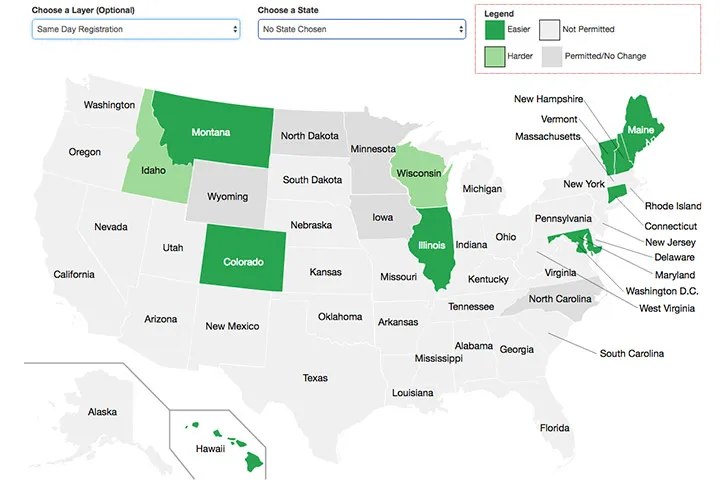Interactive U.S. Map Puts Changes in State Voting Laws into Context

The interactive map – developed in part thanks to a 2016 Summer SPEED grant - allows users to view changes to various state election voting laws over the past decade from a national perspective.
Even for the most ardent political followers, it can be difficult to track changes to state voting laws. Which states allow for early voting? Which states have tightened their voter ID laws in recent years? Which states allow online voting? These are all critically important questions, especially in an election year.
So how does someone easily navigate individual state voting laws? Enter the enterprising students in Richter Professor of Political Science Carol Nackenoff's American Elections class, who have created an interactive map that compresses the myriad changes to and differences in state voting laws into a single, easy-to-use tool.
The interactive map – developed in part thanks to a 2016 Summer SPEED grant - allows users to view changes to various state election voting laws over the past decade from a national perspective. Voting laws detailed in the map include registration rules and procedures, early voting, absentee voting, mail-in balloting, college student voting, voting by convicted felons, voter ID, and more.
Users have two options to get a better sense of state voting laws. The first involves selecting one of 16 layers – 13 of which represent a different voting law – to see a color-coded breakdown of how the laws have changed or have not changed across the nation since 2006. For an example, selecting the “Same Day Voting Registration” layer reveals that states such as Montana and Illinois have made it is easier since 2006, while states such as Wisconsin and Idaho have made it more difficult.

The second option allows users to click on a specific state for an in-depth report on its elections laws. The reports vary slightly state to state, but often include a detailed history of that state’s voting laws, a breakdown of specific rulings that have altered the laws in the past decade, and where the state’s election laws stand in the broader context of the nation.
“The goal is to provide a big picture view of voting laws across the country,” says Nackenoff. "Students get an in-depth sense of what has been changing and can see how the story in their state tends to follow - or not follow - what is going on in other states," says Nackenoff. "Students and users can see the patterns of change – including the fact that we are in an era of restricting access to the franchise – and the relationships between legislative, executive, and judicial action.”
Students in the class were assigned two states each and tasked with researching their voting laws.
For Gilbert Orbea ’19, who was assigned Indiana and his home state of New Jersey, the map provided broader context to voting law trends.
“The map allows for dense, rich information about voting law trends but with a presentation that allows one to easily navigate said information,” he says. “Considering that there are not many comprehensive resources documenting these shifts, our map is an excellent resource.” He also notes that through his research, he discovered that New Jersey has actually attempted to expand the franchise - contrary to the national trend – but legislation that would have allowed for online voting was vetoed by Governor Chris Christie.
As an international first-year student from South Korea who just moved to the United States, Nagyon Kim ‘20 was struck by the stark differences in voting laws between states.
“I thought the disparity in voting laws between the states was very interesting to research," he says, "coming from a country that has a centralized election law system that is uniform in voter registration and voting procedure across the entire nation."
Notably, he was surprised at the differences between his two assigned states – Hawaii and Alabama. “Hawaii has relatively loose election laws that could accommodate various forms of voting, such as mail-in voting and no-excuse absentee voting," he says, "as well as easier ways for voters to register, even allowing methods such as same day registration in order to increase voter turnout. In contrast, Alabama has one of the strictest election laws in the nation, particularly when it comes to felon enfranchisement.”
Anna Garner ’19, a native of Mercer, Pa., who was assigned Ohio and Minnesota, was struck by how recent rulings to voting laws will have a direct impact on this election. For example, her research revealed that a ruling as recent as September by Ohio’s state Supreme Court will eliminate a “golden week” period where citizens were able to register and cast their vote on the same day.
“I had no idea that there was so much heated debate surrounding voting laws,” she says. “Let alone laws that will affect this very election.”



